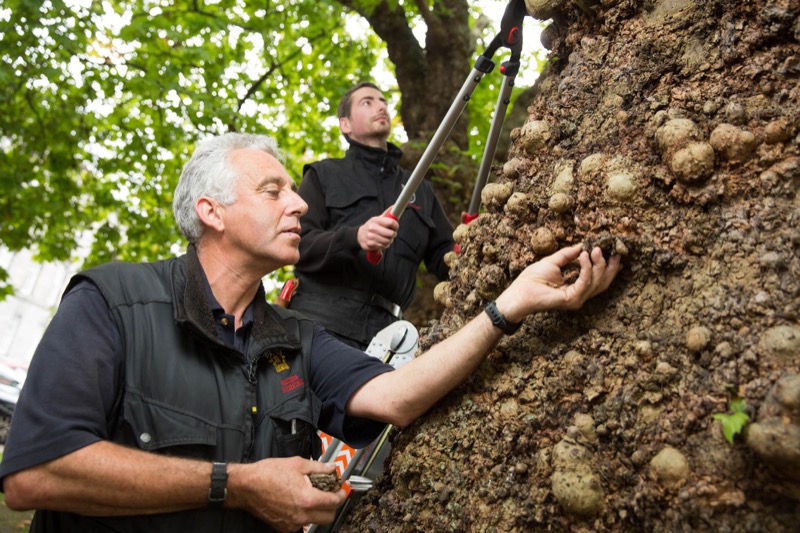The Team Behind Trinity’s Trees
Posted on: 22 September 2014
With the arrival of Autumn, the 600 trees on Trinity’s campus show a striking display of Autumnal colours which are enjoyed by staff, students and visitors alike.
The trees, which are mainly deciduous, range from all over the world. The diverse variety of trees includes, among others, eight species of maple, seven species of oak, magnolias, rowan, ash, mulberry, arbutus, alder, birch, wild cherry, holly, hawthorn, and a wych elm which is the last survivor from the epidemic of Dutch elm disease which killed 60 elms in Trinity in the 1970s.
The two famous Oregon maples in Library Square are the largest known specimens in Ireland and the UK, and possibly in Europe. It is reputed that they arose from the first consignment of seed brought back to Ireland by David Douglas in 1827. They are possibly the oldest trees in College.

The team behind maintaining the trees and campus grounds to such a high standard is headed up by David Hackett, Grounds Supervisor who has worked here for 22 years. “The Trinity campus is an oasis in the heart of a busy city with a footfall of over one million people every year. Keeping the campus looking so well is a source of pride for my team. They are so dedicated and have a keen interest in the grounds. I would like to congratulate Ben Johnson who has recently completed his Master of Horticulture from the Royal Horticultural Society of England”.
“Last year Trinity was awarded the prestigious ‘Green Flag’ for the quality of its environment, as part of An Taisce’s Green-Campus programme. The international award was the result of, and a tribute to, many years of hard work by students and staff to make the campus better environmentally managers and more sustainable”.
During the Autumn and early Winter months, the many fallen leaves swept up by the Groundsmen are brought to College’s sports grounds in Santry where they are composted.
Not all tress on campus are outside: an indoor arboretum in the Hamilton Building is home to tropical plants, including a banana tree which is 30 feet tall. Planted directly in the ground, these plants are watered by an automatic system delivering each plant a set volume of water at night.
On the main campus, the 14 Groundsmen look after the hockey, cricket, soccer, futsal and rugby pitches, lawns (including a croquet lawn), tennis courts, planting beds, 120 litter bins (36 of which are solar panelled) as well as over 600 mature trees. Additional facilities under their broad remit include the Boat Club in Island Bridge, 32 acres of playing fields in Santry, ten acres of grounds at St James’s and Tallaght hospitals, and Trinity’s Botanic Garden in Darty.
Have you ever noticed that one of the birch trees in Parliament Square on the lawns just inside Front Gate is taller than the other? The reason for this, David explains, is that Trinity was built on the site of All Hallows Priory. The archaeological remains of the medieval religious house lie beneath Front Square. The remains of the burial grounds are thought to lie directly under the west end of the campus. The two birch trees were planted on the same day and have the same genetic strain. However, after more than six decades’ growth one of the trees is considerably larger than the other. It is likely that the smaller tree has had restricted growth due to its location above masonry remains of the priory.
So which trees would David recommend to keep an eye out for in Autumn? “The crab apple and rowan trees for their fruit and autumnal leaves, the revealing of the bark of the birches and the Japanese snakebark maple when these trees lose their leaves, and the colourful leaves of all of our oak trees”.
